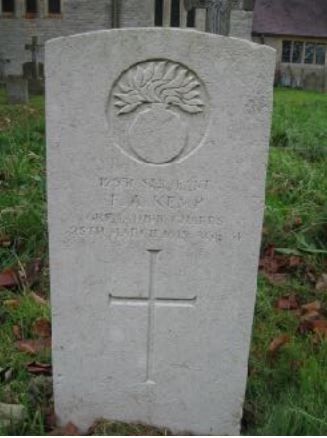2nd Battalion, Grenadier Guards

Ernest Aubry Kemp was born at Great Yarmouth, Norfolk in the final months of 1887. He was the son of John (a farm labourer) and Elizabeth Kemp. According to the 1911 Census the couple had eight children, all but one surviving at the time of the census. They lived at Caistor St Edmund, near Norfolk.
Ernest was not living with the family at that time as he was listed as a soldier at the barracks in Aldershot. Fortunately his Army Pension Record (APR) has survived at the National Archives and that reveals that he enlisted into the Army on 2 January 1906, joining the Grenadier Guards. He stated his age to be 18 years, two months at that time, his occupation as a ‘maltster’ and his address Common Road, Gorleston, Great Yarmouth. He enlisted for an initial three years with the Colours and a further nine with the Reserve.
He joined the 2nd Battalion of the Grenadier Guards and was promoted to Lance Corporal on 11 September 1906 and on the following day he extended his service with the Colours to seven years. He was promoted to Corporal on 14 May 1909 and to Lance Sergeant on 1 December 1909. His service from the time of enlistment up to the start of the Great War was in the UK.
He was discharged from the Army into the Reserve on 2 January 1913 but when war was declared on 4 August 1914 he was immediately recalled to the Grenadier Guards, re-joining them at Wellington Barracks, London on 5 August. As an experienced soldier he was appointed a full serjeant upon re-joining. Almost a week later the 2nd Grenadiers entrained at Nine Elms for Southampton and crossed the Channel aboard the SS Cawdor Castle to join the British Expeditionary Force (BEF).
The 2nd Grenadiers were involved in considerable fighting as BEF advanced to Mons and then, along with the French Army, retreated in front of the German onslaught south to the River Marne, where the tide turned. French and BEF then pushed the Germans back and the 2nd Grenadiers found themselves at Ypres. From there on trench warfare ruled until 1918.
September 1916 saw the 2nd Grenadiers fighting in what was the third month of the Somme Offensive.
On the 25th the battalion mounted an attack at Ginchy: an attack that was held up by uncut barbed wire, which officers had to cut by hand to clear gaps through which the battalion charged to take their objective with very high casualties. Serjeant Kemp was one of the casualties suffering, on that day gunshot wounds to his left hip, scalp and back. His record indicates that he was repatriated to the UK with these wounds, arriving on 29 September and that he remained having treatment and convalescence until 28 May 1917, when he returned to France to rejoin his unit. He was wounded again, slightly, on 9 October 1917 but remained in France. On 31 January 1918 he suffered from being gassed (it would appear in the lachrymatory form) and this would appear to have necessitated repatriation to the UK on 14 February 1918. He was to remain in the UK until he was discharged from the Army on 7 February 1919.
In common with all those servicemen who were discharged due to wounds or sickness Ernest Kemp was awarded a Silver War Badge (SWB), to confirm his status as a discharged veteran. The SWB register states the reason for discharge to be ‘sick — general paralysis’. His APR carries a note that upon discharge he was at the London County Asylum, Bexley, Kent, where cases of mental illness were treated. He had served on the Western Front for about three quarters of the war and would have seen heavy fighting and had suffered wounds or injury on three occasions. Could it be that all this proved too much to take and that he became one of the sad victims of ‘shell shock’ or ‘battle fatigue’ or was suffering from what is now recognised as ‘post traumatic stress disorder’? The Register of Deaths records that he died in Kent, on 28 March 1919, age 31, possibly whilst still being treated at the hospital.
Ernest had married Louisa Chapman at St James’ Church, Westminster on 8 August 1914, just prior to embarkation. They had one son, Frederick Ernest, born at Bermondsey on 24 March 1916. Louisa re-married in 1920, to Henry Snell, and was living in Minehead, Somerset at the time the CWGC Register was compiled.
Ernest had two brothers who served in the Great War, one with the Royal Marines and the other the Highland Light Infantry. Superficial research indicates they survived the war.
Serjeant Kemp is buried in the churchyard of St Matthew’s, Twigworth, where a standard CWGC headstone marks his grave. Why he is buried there, when there is no apparent connection with Gloucestershire, is unknown.
Researched by Graham Adams 26 November 2014
